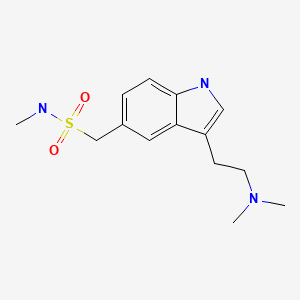Attribution Statement: LactMed is a registered trademark of the U.S. Department of Health and Human Services.
NCBI Bookshelf. A service of the National Library of Medicine, National Institutes of Health.
Drugs and Lactation Database (LactMed®) [Internet]. Bethesda (MD): National Institute of Child Health and Human Development; 2006-.
CASRN: 103628-46-2

Drug Levels and Effects
Summary of Use during Lactation
Because of the low levels of sumatriptan in breastmilk, amounts ingested by the infant are small. It also has poor oral bioavailability, further decreasing infant exposure to the drug. Some authors have suggested that withholding breastfeeding for 8 hours after a single subcutaneous injection would virtually eliminate infant exposure to the drug.[1] The manufacturer recommends withholding breastfeeding for 12 hours after a dose. Withholding breastfeeding might be helpful in extreme cases, such as in the mother of a preterm infant, but sumatriptan would not be expected to cause any adverse effects in most breastfed infants. Painful, burning nipples and breast pain have been reported after doses of sumatriptan and other triptans. This has occasionally been accompanied by a decrease in milk production.
Drug Levels
Maternal Levels. Five women who had been breastfeeding for 11 to 28 weeks received a single dose of sumatriptan 6 mg by subcutaneous injection. The peak milk level averaged 87.2 mcg/L (range 62 to 113 mcg/L) and it occurred 2.5 hours (range 1.7 to 3.5 hours) after the dose. The mean half-life in milk was 2.2 hours (range 1.2 to 3.1 hours). The authors calculated that an exclusively breastfed infant would receive 14.4 mcg in breastmilk with this dose, which is 3.5% of the weight-adjusted dosage.[1]
Seven women who were at least 1 month postpartum and used sumatriptan to treat migraine provided one milk sample before the dose, then additional milk samples at 1, 2, 4, 8, 12 and 24 hours after the dose. One mother took a 6 mg dose subcutaneously, two took 20 mg by nasal spray, four took a 50 mg oral dose (including one who used the nasal spray separately), and one mother took 100 mg orally. Peak milk levels did not correlate well with dosage, averaging 59.3 mcg/L (range 24.6 to 112.8 mcg/L) and occurred 2 to 4 hours after the dose. The average milk level was 23.2 mcg/L (range 7.7 to 50.6 mcg/L) and the half-life in milk averaged 4.9 hours (range 3.6 to 5.9 hours). The average infant’s daily dosage of sumatriptan was 3.5 mcg/kg (range 1.2 to 7.6 mcg/kg) and the weight-adjusted infant dosage averaged 0.7% (range 0.2 to 1.8%) of the maternal dose. [2]
Infant Levels. Relevant published information was not found as of the revision date.
Effects in Breastfed Infants
One author reported correspondence with the drug's manufacturer stating that of 3 women known to the manufacturer who used sumatriptan (dose and route unspecified) during breastfeeding none reported adverse effects on the infants.[3]
Effects on Lactation and Breastmilk
One author reported correspondence with the drug's manufacturer stating that 1 woman who used a single injection of sumatriptan (dose unspecified) during breastfeeding had a cessation of lactation.[3]
A review of four European adverse reaction databases found 26 reported cases of, painful, burning nipples, painful breasts, breast engorgement and/or painful milk ejection in women who took a triptan while nursing. Pain was sometimes intense and occasionally led to decreased milk production. Pain generally subsided with time as the drug was eliminated. The authors proposed that triptans may cause vasoconstriction of the arteries in the breast, nipples, and the arteries surrounding the alveoli and milk ducts, causing a painful sensation and a painful milk ejection reflex.[4]
Alternate Drugs to Consider
References
- 1.
- Wojnar-Horton RE, Hackett LP, Yapp P, et al. Distribution and excretion of sumatriptan in human milk. Br J Clin Pharmacol 1996;41:217-21. [PubMed: 8866921]
- 2.
- Amundsen S, Nordeng H, Fuskevåg OM, et al. Transfer of triptans into human breast milk and estimation of infant drug exposure through breastfeeding. Basic Clin Pharmacol Toxicol 2021;128:795-804. [PubMed: 33730376]
- 3.
- Kristensen J. Sumatriptan and breastfeeding. Aust J Hosp Pharm 1996;26:460.
- 4.
- Conijn M, Maas V, van Tuyl M, et al. Breastfeeding-related adverse drug reactions of triptans: A descriptive analysis using four pharmacovigilance databases. Breastfeed Med 2024;19:645-51. [PubMed: 38563407]
Substance Identification
Substance Name
Sumatriptan
CAS Registry Number
103628-46-2
Drug Class
Breast Feeding
Lactation
Milk, Human
Serotonin Receptor Agonists
Serotonin 5-HT1 Receptor Agonists
Triptans
Vasoconstrictor Agents
Disclaimer: Information presented in this database is not meant as a substitute for professional judgment. You should consult your healthcare provider for breastfeeding advice related to your particular situation. The U.S. government does not warrant or assume any liability or responsibility for the accuracy or completeness of the information on this Site.
- User and Medical Advice Disclaimer
- Drugs and Lactation Database (LactMed) - Record Format
- LactMed - Database Creation and Peer Review Process
- Fact Sheet. Drugs and Lactation Database (LactMed)
- Drugs and Lactation Database (LactMed) - Glossary
- LactMed Selected References
- Drugs and Lactation Database (LactMed) - About Dietary Supplements
- Breastfeeding Links
- PubChem SubstanceRelated PubChem Substances
- PubMedLinks to PubMed
- Review Zolmitriptan.[Drugs and Lactation Database (...]Review Zolmitriptan.. Drugs and Lactation Database (LactMed®). 2006
- Review Eletriptan.[Drugs and Lactation Database (...]Review Eletriptan.. Drugs and Lactation Database (LactMed®). 2006
- Review Rizatriptan.[Drugs and Lactation Database (...]Review Rizatriptan.. Drugs and Lactation Database (LactMed®). 2006
- Review Frovatriptan.[Drugs and Lactation Database (...]Review Frovatriptan.. Drugs and Lactation Database (LactMed®). 2006
- Review Almotriptan.[Drugs and Lactation Database (...]Review Almotriptan.. Drugs and Lactation Database (LactMed®). 2006
- Sumatriptan - Drugs and Lactation Database (LactMed®)Sumatriptan - Drugs and Lactation Database (LactMed®)
Your browsing activity is empty.
Activity recording is turned off.
See more...
